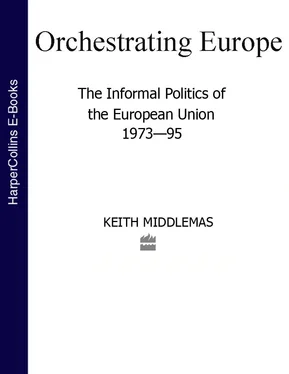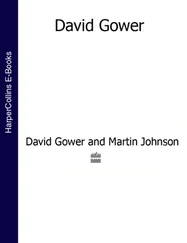Even central banks involved themselves only when the Single Market White Paper had been assimilated and monetary union come into focus as a consequence. But deregulation, particularly in Britain after 1983, led to an exuberant period of often ill-judged growth and acquisitions, followed in due course by competition in all markets for capital and financial services; excess capacity ensued, followed by retrenchment – and the same choice that had already faced key industries, between managed and market-led restructuring. Thus the market cycle, as much as changes in the formal financial environment, ensured that they would enter the EC game in the end.
Political scientists and contemporary historians dispute how far ‘industry’ can be seen as a coherent player in this game. 27Up to the late 1970s there was certainly no consistent evidence that large or multinational firms, though they were regular players at official level, had been recognized in formal Community bargaining. Insofar as they operated informally, they did so at national government level or through personal links with officials in DG3, so that with the exception of American and Swiss MNCs, which tended to go direct to both the Commission and the Parliament, influence seeped almost imperceptibly into both member states and Commission plans. The results of what they did therefore varied, being at national level more effective in France, Germany and the Netherlands than in Italy and Denmark; and at Commission level, more with DG3 than DG4. Indeed a presumption existed in most of the sectoral federations that DG4’S competition brief inhibited informal links with corporate interests, and that any formal ones should run via UNICE. Since those directives which got through the early 1980s log-jam were still framed in terms of technical harmonization, usually in the food processing industry, and since DG3 perpetuated the industrial sponsorship ethos to their satisfaction, firms and federations themselves saw no need to do more.
But when Etienne Davignon rebuilt DG3 on the Spinelli model, adding to it technological development and foreign trade elements, together with rationalization of the steel industry, this complacent attitude changed rapidly. The twelve major information technology firms willingly took part in Davignon’s research initiative which led to the promulgation of ESPRIT in 1984. On a wider scale, European corporations who benefited substantially from it generally saw the grand structural adjustment plan as a benign way to offset otherwise unacceptable political and financial imperatives from the recession of the early 1980s: redundancies, real wage cuts, benefits reductions, and some of the heavy cost of high-technology capital investment.
Considerations such as these led inevitably to firms’ preoccupation with the internal market’s potential advantages, and complemented what was always in France, and also now in Spain, a thesis about general modernization. If CBI records are typical, 28this recognition can be dated to 1980–81; that is, contemporary with Davignon’s initiative. 29However, at first its impact was confused by the vigorous polemic over Vredeling. UNICE however was not to be the vehicle, but instead a ‘high level’ informal group, aiming directly at Brussels and heads of government. 30Neither were sectors or peak organizations chosen for permeation: few of them were as yet so well based in Brussels as the Americans, and AmCham’s European Committee. But the informal groups, of which the European Round Table (ERT) became the most influential, had greater effect in the earlier period, 1982–4, when they operated informally, than afterwards. Having, as it were, gone public, they became animators, adjuncts to, rather than initiators of change. The influence of the firm has therefore to be measured in the interstices, in rivalry with louder views coming from the Parliament such as de Ferranti’s Kangaroo Group, and the 1981 Nicholson Report which claimed that the EC was ignoring industrial uncompetitiveness.
Yet this is to measure matters only on the EC stage. Some member states had gone down the Davignon road, much earlier – Britain with the Labour governments’ late 1970s Industrial Strategy, France with the Plan Barre, Germany with the Modell Deutschland. Though sectors of British government took a different view in the early 1980s, the DTI was still eager to engage the CBI’s services in its 1981 campaign for the internal market: clearly (despite the rupture between the Thatcher Cabinet and the CBI) a basis for general consensus still existed, at least in the high technology race. Something similar occurred in West Germany as the heads of much of industry came to a central standpoint on the internal market. Their French counterparts followed suit around 1983. AGREF (the Association des Grandes Enterprises Françaises), noted the conjuncture. The idea grew rapidly, according to one French company executive: ‘Europe is a kind of domestic market… the foreign markets are in America and south east Asia.’ 31The CBI and DVI, together with support from the CNPF or Patronat and Confindustria, therefore took part in Delors’s later ‘vast consultation’ with heads of enterprises across Europe. Governments in effect used their giant firms and federations to influence the Commission, complementing what national representatives were already doing in the Council of Ministers. Who used whom, and who if any one actually set the agenda, is almost impossible to decide without access to EC archives.
What matters here is that in this game, private associations like ERT were encouraged by governments and the Commission to behave as privileged actors; individual industrialists, usually with their firms’ long-term strategic advantage in mind, willingly took up the roles. UNICE, which began to call for QMV as a solution to the log-jam problem in February 1984 came later, counted for less, and was used by the Commission rather as a source to disseminate information and Commission messages. (Even less can be ascribed to the ‘Jean Monnet Committee’, reborn at the end of that year.)
The European Round Table (ERT) stands out, firstly as a collection of industrialists who led firms that were highly important, being multinationals oriented towards investments (which the Community could hope to stimulate by incentives) in telecoms, road and rail transport, and research and development. Secondly, they acted as an influence personally on Jacques Delors before, and for a short time after, he took up the Commission Presidency in January 1985. 32It was first established with Pehr Gyllenhammer (Volvo) as chief executive – a useful non-EC catalyst – and its members included Umberto Agnelli (Fiat), Wisse Dekker (Philips), Pierre Defraigne (France), John Harvey-Jones (ICI), K. Durham (Unilever), H. Maucher (Nestlé), C. Nicolin (ASEA), A. Riboud (BSN France), D. Spethmann (Thyssen), Sir Peter Baxendale (UK Shell), R. Fauroux (St Gobain), B. Hanon (Renault), O. le Cerf (Lefarge Coppée), H. Merkle (Bosch), L. von Planta (Ciba-Geigy), W. Seelig (Siemens). It had valuable links with Davignon and his successor Narjes, Fernand Braun, and Ortoli, and in that sense furthered the Commission’s idea of a pan-European, synoptic approach which was neither socialist nor corporatist. Its main general proposal was for a ‘Marshall plan for Europe’ (January 1983), the result of much debate about how to achieve reindustrialization; its main special report was written by Wissi Dekker, on behalf of Philips, in 1984 and published in January 1985.
Private and informal influence had had most effect before these publications, during 1983, in particular on the Franco-German element in the Stuttgart Declaration. 33Specifically, ERT focused directly on decision-makers (unlike the coordinating body, European Enterprise Group), proclaiming the importance of non-tariff barriers and the lack of standards, which the internal market was intended to remedy. Its suggested solutions – contained in slim, well-produced pamphlets, somewhat tinged with protectionism – were aimed at political leaders, in contrast to the more detailed literature from UNICE. What mattered most was its animator status, given the point already reached by the Commission and the German, British and French industry ministries. As Maria Green suggests, its influence was used in the direction of a unified rather than a common market, and to bring a much needed pragmatism to the debate; 34however, its later, more formal work also fed back into those member states which had stimulated it in the first place, so that it tended to replicate national lines of thought, whether for defensive adjustment or free market openness. This probably explains the CBI’s 10% area of disagreement with the Dekker Report and the DTI’s rather greater degree of divergence, enhanced of course in Margaret Thatcher’s speeches. In its crudest form of differentiation, the British version embodied an unrest-cure with contingent unemployment and bankruptcies while the German and French ones propounded a state- and industry-managed restructuring at minimal social and economic cost.
Читать дальше









![Brian Thompson - A Monkey Among Crocodiles - The Life, Loves and Lawsuits of Mrs Georgina Weldon – a disastrous Victorian [Text only]](/books/704922/brian-thompson-a-monkey-among-crocodiles-the-life-thumb.webp)


